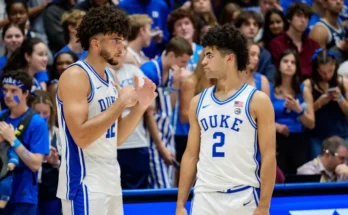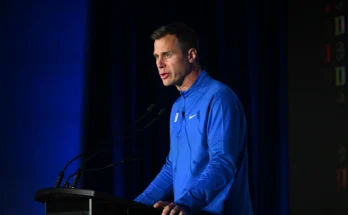Youth Rising: Vols Defense Progresses Amid Challenges as Young Talent Steps Up
In the landscape of college football, few programs carry the tradition and expectations that the Tennessee Volunteers do. As the 2025 season approaches, fans are watching closely for signs of progression, especially on the defensive side of the ball. After a 2024 campaign filled with high-scoring matchups, mixed results, and flashes of brilliance clouded by inconsistency, Tennessee has been turning the page with a determined focus on growth and development—especially when it comes to the younger players who are being thrust into pivotal roles early in their careers.
The theme of the offseason and spring practices has centered around optimism and patience. The Vols are not only rebuilding parts of their defensive identity but are doing so while relying heavily on underclassmen who have been “thrown into the fire” as coaches like to say. Head coach Josh Heupel, known for his fast-paced offensive brilliance, understands that championship-caliber teams are built on balance. And for Tennessee, that means their defense must match the offense’s tempo with discipline, toughness, and depth.
Through several weeks of spring ball and closed scrimmages, the narrative has shifted from uncertainty to confidence. Defensive coordinator Tim Banks, now entering his fourth season at the helm, has taken a proactive approach in retooling his unit. Banks, who has seen his scheme work effectively when personnel clicks, has placed increased emphasis on building situational awareness, improving open-field tackling, and fostering leadership among the younger core. The challenge lies in doing so without the benefit of years of college experience.
The departures of veterans like linebacker Aaron Beasley and defensive backs Kamal Hadden and Doneiko Slaughter left noticeable voids. But where there are losses, opportunities arise. Redshirt freshman linebacker Jeremiah Telander and sophomore safety Jourdan Thomas are among the emerging names gaining traction. Their raw talent has impressed coaches, but it’s their willingness to learn and take on responsibility that’s helping shift the culture on that side of the ball.
Telander, in particular, has drawn attention for his instinctive play and high football IQ. During a recent scrimmage, he was seen making pre-snap adjustments and communicating coverages with authority—an unusual sight for a second-year player. Banks praised his growth, calling him “one of the most coachable young defenders we’ve had.” His speed sideline-to-sideline and ability to diagnose plays quickly have allowed the defense to remain aggressive, even in the absence of older veterans.
In the trenches, defensive line coach Rodney Garner continues to mold a group full of potential. Freshman defensive end Caleb Herring and sophomore tackle Tyre West are among the names pushing for starting reps. Herring’s explosiveness off the edge is reminiscent of past Tennessee greats, and though he still needs to bulk up to handle SEC-level physicality, his motor and effort are unquestioned. West, meanwhile, has been a stabilizing force inside, with better conditioning and improved pad level contributing to a strong spring.
The secondary has seen a similar youth movement. The cornerback group, a source of frustration at times last season, has benefitted from the arrival of early enrollee Kaleb Beasley—no relation to Aaron—who has quickly acclimated to the demands of the college game. While cornerback is often one of the toughest transitions for freshmen, Beasley’s confidence and length have stood out. Paired with sophomore Rickey Gibson III, who has taken a significant leap in both technique and physicality, Tennessee’s defensive backfield is beginning to form an identity rooted in competitiveness and grit.
Defensive backs coach Willie Martinez has emphasized fundamentals and reducing mental mistakes. Last season, Tennessee’s defense gave up several big plays due to blown coverages and miscommunication. This spring, film sessions have been intense, with position groups holding each other accountable. The idea is to eliminate the margin for error that plagued them previously. And while perfection is unrealistic, the unit is trending in the right direction.
Of course, progression on defense isn’t solely about individual performance. It’s about cohesion—11 players executing as one. And this is where Tennessee seems to be turning a corner. During practices, there’s a noticeable uptick in communication and energy. Veteran leaders like defensive tackle Omari Thomas and edge rusher James Pearce Jr. have embraced their roles as mentors. Pearce, who is widely projected to be a future first-round NFL draft pick, has taken younger players under his wing, sharing film habits, recovery tips, and pass-rush techniques. His leadership by example has fostered a stronger culture of accountability within the defensive line.
Pearce’s own development has been nothing short of remarkable. His blend of size, speed, and bend off the edge makes him a nightmare for offensive tackles. But beyond his athletic gifts, it’s his understanding of scheme and leverage that has elevated his play. With opposing offenses focusing on neutralizing him, his presence alone frees up opportunities for other defenders—a reality that Telander and Herring are already capitalizing on.
Off the field, Tennessee’s strength and conditioning program deserves credit as well. Led by Kurt Schmidt, the program has prioritized explosiveness and injury prevention. Young players entering the program are benefitting from tailored regimens designed to maximize their physical potential without overloading them early in their development. The result? A defense that looks faster, stronger, and more durable.
As the Vols progress through the final stages of spring practice, the coaching staff remains measured in their evaluations. Scrimmage stats and highlight plays are valuable, but the true litmus test will come in the fall when these young players face live bullets in hostile SEC environments. Still, there’s little doubt that the foundation is being laid now.
There’s also something to be said for the intangibles. The attitude among the defensive unit has shifted. Where there was once hesitation, there is now hunger. Where there was inexperience, there is now the fire to learn. Young players, thrown into the fire due to necessity, are emerging as future stars because of it. There’s a growing belief within the locker room that this defense won’t just be better than last year’s—it could become the backbone of Tennessee’s next great team.
Fans will get their first real look at the defense during the upcoming Orange & White Game, where many of these young players are expected to feature heavily. It will be the public’s chance to witness what insiders and coaches have seen all spring: a defense in transition, but one brimming with promise.
There’s still work to do, of course. Depth remains a concern in certain positions, particularly at linebacker and safety, where injuries could quickly expose inexperience. But with each practice rep, film session, and weight room grind, this group gets closer to becoming a strength rather than a liability.
In the ever-competitive SEC, patience can be a luxury few teams can afford. But Tennessee’s coaching staff appears committed to developing their young core the right way—not by rushing them but by empowering them. If the early signs of spring are any indication, that patience could pay off in a big way this fall.
For Tennessee fans, it’s an exciting time. The future of the defense isn’t just potential—it’s already taking shape in the form of hungry, talented young players rising to meet the challenge. And if this group continues its upward trajectory, the Vols might just have the makings of a defense that can complement their explosive offense and push them even closer to an SEC title.



